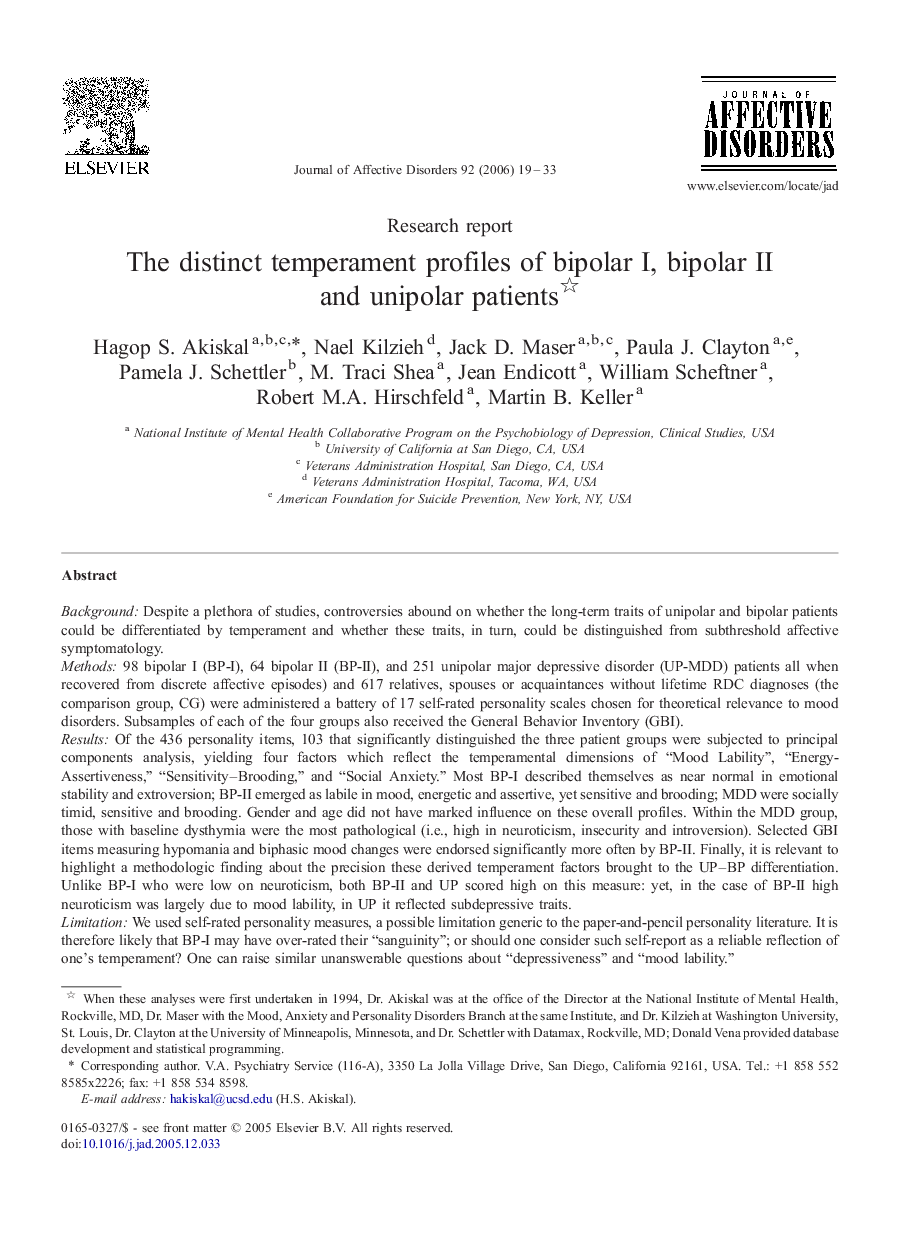| کد مقاله | کد نشریه | سال انتشار | مقاله انگلیسی | نسخه تمام متن |
|---|---|---|---|---|
| 4188199 | 1277660 | 2006 | 15 صفحه PDF | دانلود رایگان |

BackgroundDespite a plethora of studies, controversies abound on whether the long-term traits of unipolar and bipolar patients could be differentiated by temperament and whether these traits, in turn, could be distinguished from subthreshold affective symptomatology.Methods98 bipolar I (BP-I), 64 bipolar II (BP-II), and 251 unipolar major depressive disorder (UP-MDD) patients all when recovered from discrete affective episodes) and 617 relatives, spouses or acquaintances without lifetime RDC diagnoses (the comparison group, CG) were administered a battery of 17 self-rated personality scales chosen for theoretical relevance to mood disorders. Subsamples of each of the four groups also received the General Behavior Inventory (GBI).ResultsOf the 436 personality items, 103 that significantly distinguished the three patient groups were subjected to principal components analysis, yielding four factors which reflect the temperamental dimensions of “Mood Lability”, “Energy-Assertiveness,” “Sensitivity–Brooding,” and “Social Anxiety.” Most BP-I described themselves as near normal in emotional stability and extroversion; BP-II emerged as labile in mood, energetic and assertive, yet sensitive and brooding; MDD were socially timid, sensitive and brooding. Gender and age did not have marked influence on these overall profiles. Within the MDD group, those with baseline dysthymia were the most pathological (i.e., high in neuroticism, insecurity and introversion). Selected GBI items measuring hypomania and biphasic mood changes were endorsed significantly more often by BP-II. Finally, it is relevant to highlight a methodologic finding about the precision these derived temperament factors brought to the UP–BP differentiation. Unlike BP-I who were low on neuroticism, both BP-II and UP scored high on this measure: yet, in the case of BP-II high neuroticism was largely due to mood lability, in UP it reflected subdepressive traits.LimitationWe used self-rated personality measures, a possible limitation generic to the paper-and-pencil personality literature. It is therefore likely that BP-I may have over-rated their “sanguinity”; or should one consider such self-report as a reliable reflection of one's temperament? One can raise similar unanswerable questions about “depressiveness” and “mood lability.”ConclusionAs contrasted to CG and published norms, the postmorbid self-described “usual” personality is 1) sanguine among many, but not all, BP-I; 2) labile or cyclothymic among BP-II; and 3) subanxious and subdepressive among UP. It is further noteworthy that with the exception of BP-II, the temperament scores of BP-I and MDD were within one SD from published norms. Rather than being pathological, these attributes are best conceived as subclinical temperamental variants of the normal, thereby supporting the notion of continuity between interepisodic and episodic phases of affective disorders. These findings overall are in line with Kraepelin's views and contrary to the DSM-IV formulation of axis-II constructs as being pathological and sharply demarcated from affective episodes.
Journal: Journal of Affective Disorders - Volume 92, Issue 1, May 2006, Pages 19–33